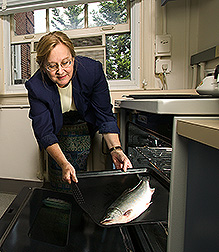Nutrient Database To Help Native Communities
|
|
ARS nutritionist Pamela Pehrsson and colleagues are developing a database that will list the nutrient content of about 200 traditional foods commonly eaten by American Indians and Alaska Natives. Because dietary practices and disease patterns among these communities differ from those of the general U.S. population, the data is critical to the ability of health care workers to provide appropriate nutrition guidance.
Pehrsson is with ARS’s Nutrient Data Laboratory (NDL) in Beltsville, Maryland. She obtained project funding from the Indian Health Service, headquartered in Rockville, Maryland, and the National Institutes of Health’s Office of Research on Minority Health, in Bethesda, Maryland.
NDL personnel are now coordinating collection and analysis of food samples from reservations and from northern and western Alaska.
“So far, we’ve collected samples from Apache, Shoshone-Bannock, and Navajo reservations as well as from various tribal villages around Alaska,” says Pehrsson. Tribes are being selected from across the United States to get a broad sampling of foods.
Nutritionists within those native communities will be able to use the database to develop dietary recommendations for the local population. They’ll also be able to assess nutritional adequacy of group and individual diets. And the data will enable health care workers to design dietary therapies for people with diabetes and other health problems; plan menus for school, hospital, and other group-meal situations; and conduct research on the relationships between diet and disease risk.
“The data will be used for nutrition education and diet counseling, either by tribal health organizations or by federal and state health organizations,” says Pehrsson. “For example, at a clinic set up on the Navaho reservation, tribal health-care workers are already using the data for diet counseling in an effort to reduce the incidence of diabetes and obesity there.”
The USDA American Indian/Alaska Native Foods Database is slated for launch through the NDL website in 2006. Meanwhile, native foods that have already been analyzed are being added to NDL’s comprehensive nutrient database of more than 7,000 foods.—By Rosalie Marion Bliss, Agricultural Research Service Information Staff.
This research is part of Human Nutrition, an ARS National Program (#107) described on the World Wide Web at www.nps.ars.usda.gov.
Pamela R. Pehrsson is with the USDA-ARS Nutrient Data Laboratory, 10300 Baltimore Ave., Bldg. 005, Beltsville, MD 20705-2350; phone (301) 504-0716, fax (301) 504-0713.
"Nutrient Database To Help Native Communities" was published in the September 2005 issue of Agricultural Research magazine.








